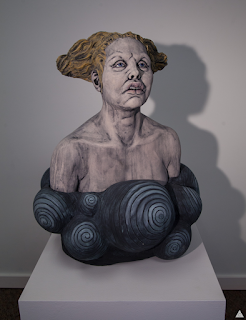By Alec Clayton
Published in the Weekly Volcano, Sept. 28, 2017
 |
| “Operative Hyena with Rabbit?” ceramic sculpture by Joe Batt, courtesy South Puget Sound Community College |
 |
| “Where’s the Xanax?” mixed media by Liza Brenner, courtesy South Puget Sound Community College |
When walking into
the art gallery at South Puget Sound
Community College, the first thing to greet the eye is a curtain of hanging
white porcelain shapes suspended by clear monofilament line. It is like a bead
curtain, but it is not beads. It is a representation of genome sequencing. It
is called “The Life and Genome of Henrietta Lacks.” Lacks was an African-American
woman whose cancer cells were used in breakthrough medical studies. Some of the
white porcelain forms look like bones, some like figures. Looking at it, I was
reminded of dancing skeleton puppets. So we have here an intriguing piece of
art that reflects on science and history, and which is a visual treat.
From a
contemplation of genomes we go to geology with Sean Barnes’s series of
sculptures using anthropogenic materials and processes. There is one
free-standing sculpture on a pedestal that looks like quartz and other rock
formations fused together. Within it is a cell phone case that appears to be
part of the rock. Nearby is a group of similar works in box frames that hang on
the gallery wall. All are rough and gritty organic abstractions that combine
natural geologic formations with man-made items such as tape, a shard from a
broken tea cup. They are visual representations of the essential beauty of
natural and made materials. Part of the beauty of it is that the made materials
tend to disappear into the natural rock.
As art depicting
genomes lead the eye and mind to anthropogenic materials, we next go to a
series of works by Joe Batt that combine animals and humans with cell phones,
towers and space exploration. We have seen in previous shows and entire gallery
installations at SPSCC, Tacoma community College and Salon Refu that Batt
continually creates worlds of electronic communications wherein animals and
humans become part of the mechanical and scientific worlds humans have created.
Here we see a group of hyenas with electronics strapped to their backs
confronting a white bunny rabbit. One of the hyenas is vicious looking, making
the viewer wonder what kind of horrifying future world we are seeing and how
near are we to seeing it become reality.
Batt is also
showing a charcoal drawing done directly on the gallery wall with digitally
collaged images of people, birds, an elephant and a cell phone tower on the
face of a mountain. The textures and drawing are quite intriguing due to the
manner in which the actual texture of the wall blends with the illusory texture
of the drawing.
Liza Brenner is
showing two large mixed-media depictions of urban scenes that seem to be set in
an earlier time, perhaps the 18th century. I approached these with
mixed reactions, thinking on the one hand that they are too illustrational and
almost corny, but admiring the artist’s technical skill and some of the
surrealistic elements such as shadowy figures and a snake wearing a crown.
I admired Nathan
Barnes’s two works, “Stifle” and “Diaspora.” These are pop-surreal images
typical of the work for which Barnes is well known. They are colorful, strange,
and beautifully executed with great skill and attention to detail. I had an
opportunity to talk to Barnes about these pieces and learned that the models
for the faces, like the models for many of his constructed paintings, were
relatives, and that every element in them refers to something historical or
personally relevant, Whether or not the viewer is privy to the stories behind
his paintings, they are fascinating to look at. Make up your own stories, and
then if Barnes, who manages the gallery, happens to be there, ask him to
explain.








